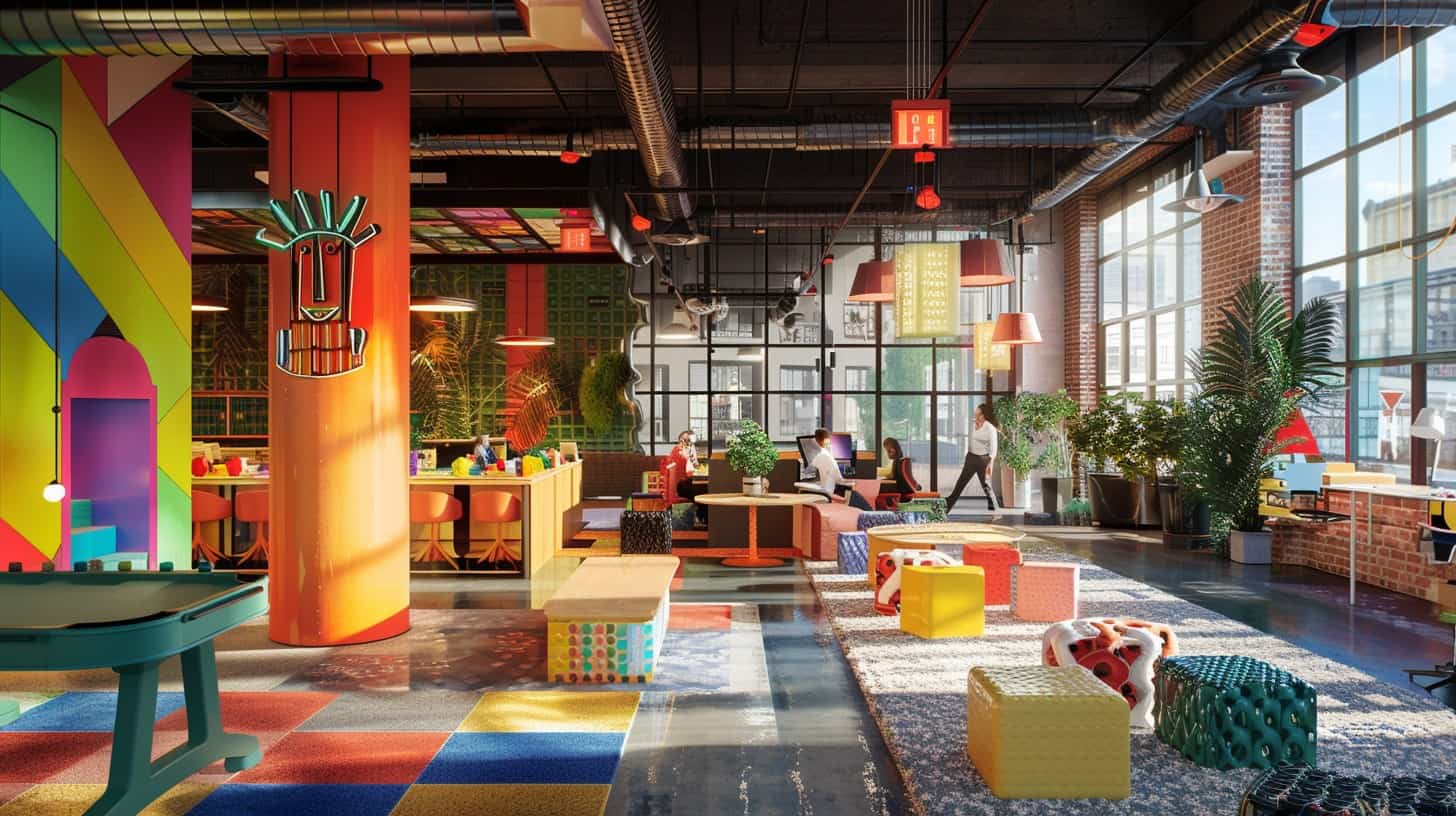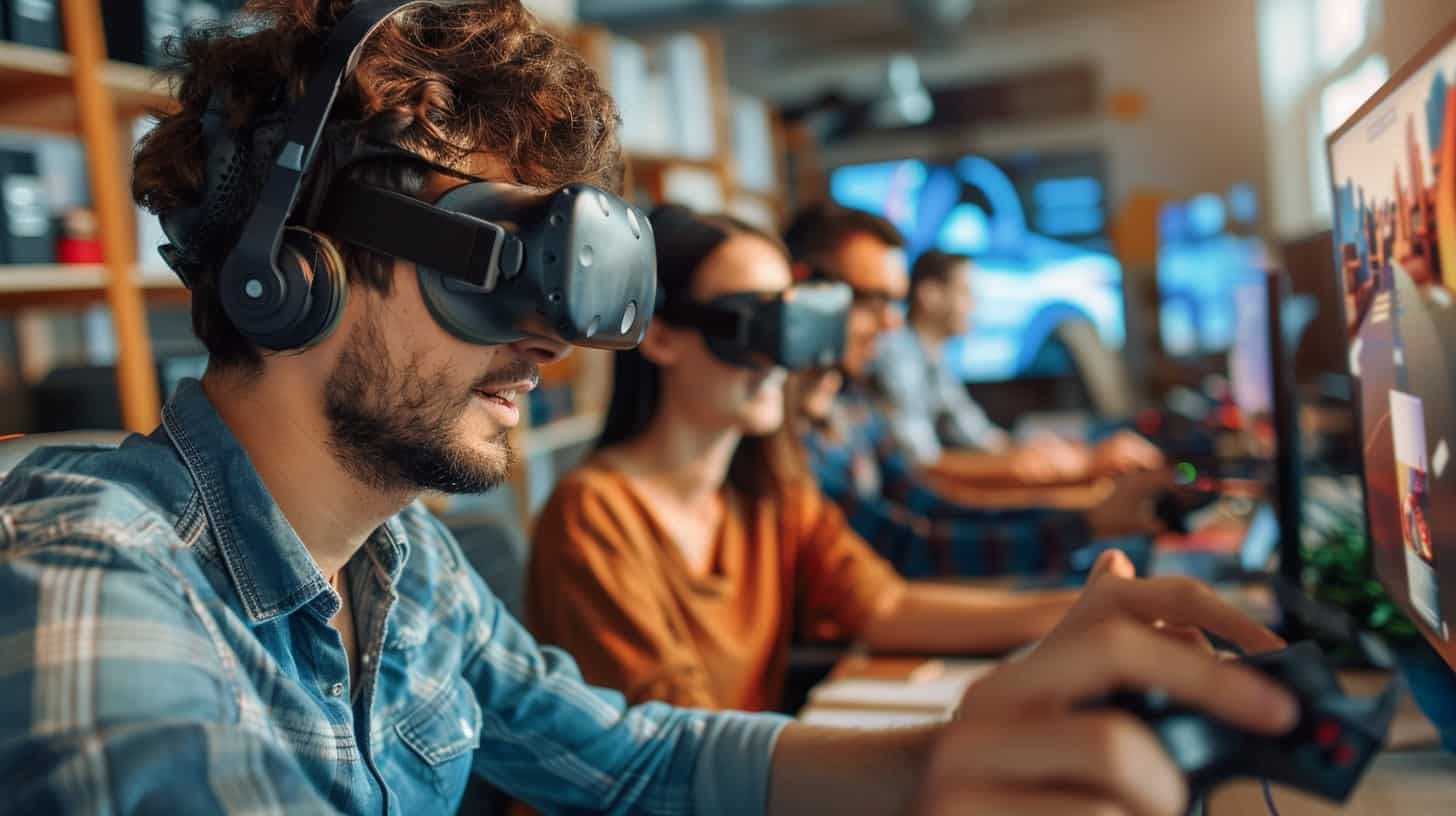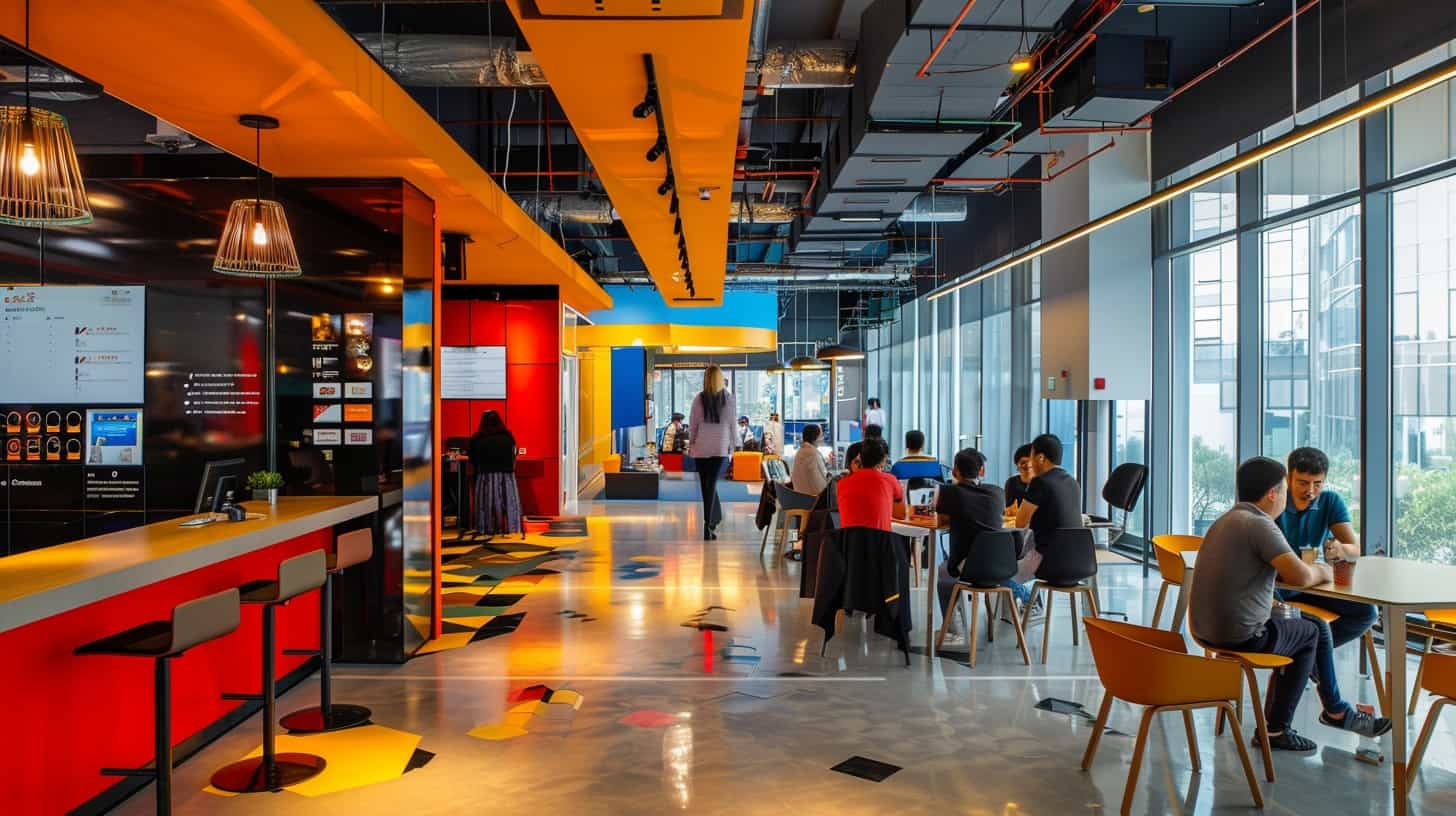Are your teams stuck in a rut? Gamification at work is becoming a game-changer. This strategy motivates 72% of people to push harder and achieve more. Our article will guide you through making gamification your next big move for team growth.
Get ready to play!
Key Takeaways
Gamification at work uses game elements like points and leaderboards to make tasks more fun and engaging, increasing motivation among 72% of employees.
It boosts learning, reduces stress, draws younger workers, enhances engagement and motivation, encourages desired behaviors, and makes training more impactful with clear goals.
Companies such as Vantage Circle and IBM successfully use gamification to turn everyday tasks into exciting challenges that attract young talent.
Meaningful rewards including personal recognition and non-monetary perks promote a positive work environment where achievements are celebrated in front of peers.
Despite its benefits, gamification must be implemented carefully to avoid creating unhealthy competition or relying too much on external rewards, which can demotivate employees.
Table of Contents
Understanding Gamification in the Workplace

Gamification in the workplace takes a page from video games, mixing work with play. It’s all about adding game elements to job tasks. Think points, badges, and leaderboards. These aren’t just for fun; they’re tools to fire up motivation and engagement among employees.
Companies like Vantage Circle and IBM are already on this bandwagon, turning everyday work into thrilling quests.
This strategy taps into our love for games and competition. Imagine earning rewards for finishing projects or learning new skills through interactive e-learning courses. It makes the grind feel less like work and more like an adventure.
With these methods, employers aim to keep teams motivated and focused on their goals, paving the way toward enhancing employee training and incentives.
Benefits of Gamification at Work

Gamification at work can turn the daily grind into a fun, exciting journey. It lights a fire under employees, pushing them to learn more and stress less.
Making Learning Fun and Engaging
Learning turns into a game, grabbing everyone’s attention. It taps into the joy we find in games, making even complex topics easy to digest. This approach isn’t just about having fun; it’s scientifically proven to help us learn better.
Games naturally engage our minds, encouraging us to dive deeper and pay more attention.
This strategy especially appeals to the younger workforce, who grew up with video games and apps as their primary forms of entertainment. It slashes stress levels too, transforming the usual yawn-inducing training sessions into exciting challenges.
Think of it like turning spinach into a smoothie – same benefits but way tastier!
Reducing Employee Stress
As learning becomes more fun and engaging through gamification, stress in the workspace starts to melt away. Gamified tasks turn boring routines into exciting challenges. This is important because nearly 90 percent of employees report feeling more productive and less stressed when their jobs include game-like elements.
In the context of ‘overemployed jobs,’ where individuals might experience heightened levels of stress due to handling multiple roles, gamification at work can be a stress-reliever. Transforming complex tasks into game-like challenges not only distracts from the stress of multitasking but also contributes to a more manageable workload, making each task feel like a small, conquerable game rather than an insurmountable challenge. It’s a strategy that elegantly combines productivity with mental wellness.
Gamification brings a breath of fresh air to daily work. Simple rewards or public recognition for completing tasks can boost morale. It turns the pressure cooker environment of deadlines and targets into a playground where achievements are celebrated, reducing burnout significantly.
Employees find themselves motivated not just by salary, but by the satisfaction of leveling up and earning badges for their accomplishments.
Attracting a Younger Workforce
Gamification in the workplace is like a magnet for young talent. Companies such as Vantage Circle and IBM have cracked the code by embedding gamified elements into their work culture. By using gamification to attract young talent, companies not only foster a dynamic and engaging work environment but also position themselves to innovate and make money in an increasingly competitive market.
This strategy speaks directly to Gen Z, making them feel right at home. It’s not just about tasks and targets; it’s turning everyday work into an engaging game they’re eager to play.
Young professionals crave environments where they can grow and shine. By gamifying tasks, feedback, and recognition, businesses create a dynamic space that feeds this need. They’re not only working but also playing towards their next achievement or reward.
This fresh approach keeps motivation high and ties directly to job satisfaction, making these companies hot spots for ambitious young minds ready to make their mark.
Boosting Employee Engagement & Motivation
After drawing in a younger workforce, the next step is to keep them hooked and productive. That’s where gamification shines in boosting employee engagement and motivation. Almost 90 percent of workers report feeling more productive with game elements added to their work routine.
It turns out that leaderboards, instant feedback, and public recognition do more than just add fun; they make employees feel valued and understood. These strategies speak directly to intrinsic motivations by rewarding progress and fostering a competitive yet collaborative environment.
By incorporating these gaming mechanics into daily tasks, companies see a surge in energy levels among teams. Employees are keen to tackle challenges when they know there’s a badge or leaderboard spot waiting for them on the other side.
This approach transforms mundane tasks into exciting missions. And it doesn’t stop there; healthy competition among peers sparks creativity and innovation, pushing teams to not only meet but exceed performance metrics.
In essence, gamification taps into the geeky love for achievements while promoting personal growth and team success.
Encouraging Desired Behavior
Gamification turns work into a game, making employees more eager to hit their goals. It’s like having cheat codes for motivation. By setting up leaderboards or giving digital badges for achievements, we ignite a fire under team members.
They’re not just working; they’re on a quest to beat levels and earn rewards. This strategic play taps into our love for games, nudging everyone towards better performance almost without them noticing.
Let’s talk real magic—feedback loops from gamification fast-track learning and improvement. Instant kudos or points for tasks well done keep spirits high and fuel the drive to do even better next time.
This isn’t about dangling carrots forever out of reach; it’s creating a culture where every win is celebrated, big or small. Employees get hooked on that feeling of accomplishment, constantly pushing themselves further in this setup designed for success.
Effective Implementation of Gamification

To nail gamification at work, you’ve got to play your cards right. It’s all about hitting the sweet spot between fun and function without dropping the ball.
Setting Clear Goals and Rules
Gamification in the workplace makes tasks exciting. It’s crucial to set clear goals and rules for it to work well. Here’s how you can achieve that:
- Define what success looks like: Start by painting a clear picture of the objectives. This could be improving sales numbers, boosting team collaboration, or enhancing customer service skills.
- Make the rules simple yet specific: Everyone should easily understand what they need to do and how to do it. Avoid complicated instructions that might confuse rather than guide.
- Align goals with your company’s mission: Ensure the gamification aligns with larger organizational aims. If your company prioritizes innovation, tailor games towards creative processes and problem-solving.
- Communicate expectations clearly: Use meetings, emails, or an intuitive dashboard to share what outcomes you expect from employees engaging in these gamified tasks.
- Set up a tracking system: Use tools like Google Analytics or custom ERPs to monitor participation and progress. This keeps everyone honest and motivated by showing real-time results.
- Update goals periodically: Markets change, and so should your goals to stay relevant and challenging for employees.
- Offer feedback continuously: Constructive criticism helps players improve, while praise boosts motivation. Both are necessary for growth and engagement.
With these steps in place, transitioning into incorporating gamification into training becomes smoother and more impactful.
Incorporating Gamification into Training
Gamification turns the mundane into the extraordinary. It taps into our love for games, making learning at work feel more like play and less like a chore. Here’s how to weave gamification into your training programs:
- Identify clear objectives. Start by knowing what you want your team to learn or achieve. This ensures that the game elements you introduce serve a purpose beyond just being fun.
- Choose relevant game mechanics. Leaderboards, points, and badges aren’t just cool; they tap into our natural desires for competition and achievement, making learning stickier.
- Create immediate feedback loops. Use quizzes and interactive tasks that tell employees right away how they’re doing. This keeps them engaged and informs them about what they need to improve on without delay.
- Design challenges that mirror real – life tasks. Employees should see a direct link between the game and their daily responsibilities. This makes the learning experience more meaningful and applicable.
- Foster social connections through team – based challenges. Learning together builds camaraderie and encourages knowledge sharing, turning training sessions into opportunities for team growth.
- Offer rewards that matter. Go beyond virtual achievements with incentives like extra time – off or gift cards for top performers. These tangible rewards boost motivation and encourage participation.
- Leverage technology for immersive experiences online courses, elearning technologies, and virtual reality can make training interactive and engaging, especially for remote teams.
By integrating these steps into your training programs, you turn learning into an adventure employees want to embark on every day, leveraging their natural enthusiasm for games to fuel their professional growth.
Offering Meaningful Rewards
Gamification at work isn’t just a trend; it’s a game-changer for team growth. Offering meaningful rewards can transform your workplace into a hive of activity and enthusiasm. Here’s how to nail it:
- Align rewards with personal goals: Employees shine when their work goals match their personal aspirations. A reward system that honors these individual goals fuels motivation and satisfaction.
- Think beyond cash: Sure, everyone loves a bonus, but non-monetary rewards like extra vacation days, premium health insurance options, or even a prime parking spot can have a huge impact.
- Make it social: Recognition in front of peers can be just as rewarding as tangible gifts. Use social media platforms or internal channels to shout out achievements.
- Tailor rewards to fit the achievement: Small wins deserve celebration too, but save the big prizes for major milestones. This approach keeps everyone gunning for the next level without feeling overlooked.
- Keep it fresh: Rotate rewards to keep anticipation high. What’s appealing one month might become stale the next, so stay innovative with your incentive program.
- Tie rewards to company values: This not only reinforces what matters most to your business but also builds a culture where those values are lived daily by everyone.
- Offer educational opportunities: For the geeks in all of us, access to new learning resources or tech gadgets can be incredibly motivating, pushing us to achieve more for those sweet, sweet perks.
- Include team-based rewards: Foster collaboration by offering incentives that teams can earn together, like group outings or team dinners, encouraging unity and collective effort.
- Personalize it: Show you know your team by customizing rewards. A personalized gift shows thought and appreciation far beyond a generic token would.
- Employ analytics for fairness: Use data from performance tracking tools to ensure fairness in how rewards are distributed, keeping everyone on an equal playing field.
By striking the right balance with these strategies, you’ll not only boost productivity but also build a workplace that buzzes with energy and innovation.
Recognizing Participation
Recognizing participation turns the spotlight on every player in the game, not just the high scorers. Imagine getting a digital high-five for your efforts or seeing your name up in lights on an interactive leaderboard.
It’s like being a geeky hero for doing your day-to-day tasks. This public nod can boost morale and make everyone feel valued, turning mundane tasks into moments of victory.
Offering meaningful rewards alongside recognition ensures everyone stays motivated and engaged. Think about it – wouldn’t you work harder if you knew there were cool gadgets or extra vacation days up for grabs? Plus, sharing these wins across cross-functional teams fosters a sense of community and healthy competition that keeps the energy high and the spirits lifted.
Tracking Performance with Analytics
After recognizing participation, tracking performance with analytics takes the spotlight. Using data lets us see how well employees are doing. It’s like having a high-score board but for work tasks.
Analytics show who’s nailing their goals and who might need a boost.
Tools that track performance turn numbers into insights. They help bosses make smart decisions based on real results, not just gut feelings. This way, everyone knows what’s working and what needs change to keep winning at work.
Examples of Successful Workplace Gamification

Many companies have hit the jackpot by weaving game elements into their daily grind. Check out how a splash of competition and rewards can transform the humdrum into high scores in office morale.
Game-Based Learning
Game-based learning takes the bore out of corporate training. Imagine leveling up your skills like a video game character, where each quest completed rewards you with new abilities and knowledge.
This method turns dull lectures into interactive missions, making the learning process a thrilling adventure. It’s not just fun and games; it engages employees deeply, boosting their motivation to learn.
Companies have seen productivity soar by incorporating immediate feedback and public recognition into these games. Employees aren’t just sitting through another PowerPoint presentation; they’re actively participating in their growth journey.
With every challenge conquered, learners gain intrinsic rewards that fuel their drive for success. This approach doesn’t only make learning engaging, but aligns closely with true business gamification principles, focusing on long-term benefits rather than quick wins.
On-the-Spot Recognition
Shifting gears from game-based learning, on-the-spot recognition takes the thrill of instant feedback and applies it directly in the workplace. This strategy taps into real-time responses to employee actions, making every achievement feel like a victory lap.
It’s about giving a high-five in the moment, turning small wins into big celebrations.
Imagine nailing a tough project or solving a tricky problem and getting immediate applause from your team and leaders. That’s on-the-spot recognition for you. It fuels motivation and inspires everyone to keep pushing forward, knowing their hard work doesn’t go unnoticed.
Plus, it’s perfect for boosting morale during those long coding marathons or after crunching numbers all day.
Interactive Leaderboards
Interactive leaderboards bring a dash of excitement to the daily grind. They light up the competitive spirit in employees, pushing them to improve their game. By showcasing everyone’s performance openly, these boards stir up a healthy race for excellence.
They’re not just about who gets the top spot; they also celebrate personal bests and milestone achievements.
Leaderboards do more than motivate; they transform mundane tasks into engaging challenges. Imagine watching your name climb up the ranks after nailing a project or closing a deal. This visual progress boosts morale and fosters a vibrant, dynamic work environment where everyone is geared towards doing their best.
With careful implementation, they ensure that competition remains friendly and drives teamwork rather than division.
Drawing Inspiration from Casino Gamification Strategies

Casinos know how to grab attention. They use bright lights, big wins, and a sense of adventure to keep people coming back. In the workplace, taking a page from their playbook could add that sparkle to everyday tasks.
For instance, consider the casino review site No Wagering, which shines in the UK gambling scene by making it easier for players to find thrilling games without hidden catches. This approach mirrors effective gamification at work—making rewards clear and straightforward boosts motivation.
Creating competition with leaderboards or setting up missions employees can complete feels like hitting a jackpot when done right. It’s not just about winning; it’s about feeling part of something bigger and being recognized for your efforts.
Just like casinos layer free spins or loyalty points, workplaces can offer badges for skill development or milestones achieved. This strategy not only improves job performance but also turns routine into an exciting quest for growth.
Potential Drawbacks of Gamification

Gamification isn’t all fun and games. Sometimes, it can actually do more harm than good. If not handled carefully, gamification can lead to demotivation and a sense of complacency among team members.
Think about it: nobody wants to feel like they’re just chasing the next reward rather than genuinely enjoying their work or contributing in a meaningful way.
Creating a healthy level of competition is crucial, but it’s equally important not to push too hard. Overdoing the competition aspect can scare off people from even trying. Also, relying solely on external rewards such as gift cards or products might make employees feel undervalued.
They could start seeing these perks as the only reason to put in effort, which isn’t exactly a recipe for long-term engagement or satisfaction at work.
FAQs About Gamification at Work
What’s gamification at work all about?
Think of gamification as turning work tasks into mini-games. It makes the daily grind more fun, boosts team spirit, and can even help folks learn new skills without feeling like they’re stuck in a classroom.
Can playing games at work really help us do better?
Absolutely! Adding game elements to work tasks lights a fire under people, making them want to achieve more. It’s like when you try to beat your high score in a video game, but this time it’s for hitting sales targets or finishing projects.
How does gamification keep employees from quitting?
When work feels more like play, people stick around. Gamification adds that spice to the workplace that keeps tech jobs interesting and rewarding, so saying goodbye is harder than you’d think.
Will adding game-like features make my team healthier?
You bet! Think Fitbit challenges, but for every part of your day-to-day tasks. This approach encourages everyone to move more, eat better, and balance their workload with life outside the office.
Does this mean I need fancy tech to start gamifying our workspace?
Not really! You can kick things off with simple ideas like leaderboards for sales reps or reward badges for great customer feedback—no high-tech gadgets required unless you’re ready to level up!
How do I know if my team’s winning at this whole gamification thing?
Keep an eye on the scoreboard—your business metrics and employee feedback will tell you everything you need to know about how well these changes are playing out.



